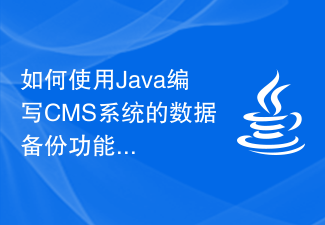 Backend Development
Backend Development PHP Tutorial
PHP Tutorial PHP asynchronous coroutine development: speed up data backup and recovery
PHP asynchronous coroutine development: speed up data backup and recovery
PHP asynchronous coroutine development: Accelerate data backup and recovery, specific code examples are required
As the amount of data used in modern applications continues to increase, data Backup and recovery are becoming increasingly important. However, traditional data backup and recovery processes are often very time-consuming and can take a lot of time to process large amounts of data. In order to speed up data backup and recovery, we can use PHP asynchronous coroutine development technology.
PHP asynchronous coroutine development is a programming model that uses the coroutine mechanism to achieve asynchronous non-blocking. By using asynchronous coroutines, multiple tasks can be processed simultaneously without waiting for the completion of the previous task. This concurrent processing method can significantly improve the running efficiency of the program.
For the process of data backup and recovery, we can divide it into multiple small tasks, and then use PHP asynchronous coroutines to process these tasks concurrently. Below we use a specific example to demonstrate how to use PHP asynchronous coroutines to speed up data backup and recovery.
Suppose we have a database that stores a large amount of user data. We need to back up this data to another database and restore it back when needed. The traditional approach is to use an iterative method to traverse the database and copy the data to the target database one by one. This method is very time-consuming, because each piece of data copied needs to wait for the IO operation of the database to be completed.
The following is a sample code that uses PHP asynchronous coroutines to accelerate data backup:
<?php
use SwooleCoroutine;
use SwooleCoroutineMySQL;
$sourceDbConfig = [
'host' => '127.0.0.1',
'port' => 3306,
'user' => 'root',
'password' => 'password',
'database' => 'source_db',
];
$targetDbConfig = [
'host' => '127.0.0.1',
'port' => 3306,
'user' => 'root',
'password' => 'password',
'database' => 'target_db',
];
function backupData($sourceDbConfig, $targetDbConfig)
{
$sourceDb = new MySQL();
$targetDb = new MySQL();
// 连接源数据库
$sourceDb->connect($sourceDbConfig);
// 连接目标数据库
$targetDb->connect($targetDbConfig);
// 查询源数据库中的数据
$data = $sourceDb->query('SELECT * FROM users');
// 并发插入数据到目标数据库
Coroutine::create(function () use ($targetDb, $data) {
foreach ($data as $row) {
Coroutine::create(function () use ($targetDb, $row) {
$targetDb->insert('users', $row);
});
}
});
$sourceDb->close();
$targetDb->close();
}
backupData($sourceDbConfig, $targetDbConfig);The above code uses the Coroutine and MySQL classes provided by the Swoole extension. By creating a coroutine, we can handle multiple insert operations simultaneously in the same coroutine without waiting for the completion of each insert operation.
By using PHP asynchronous coroutine development technology, we can speed up data backup and recovery, saving a lot of time and resources. However, it should be noted that when using PHP asynchronous coroutine development, you need to pay attention to the connection and closing of the database, as well as coroutine scheduling and other issues.
In short, PHP asynchronous coroutine development is an effective way to speed up data backup and recovery. By rationally using asynchronous coroutine technology, we can easily realize the process of concurrent processing of data backup and recovery and improve the operating efficiency of the program. Hope this article is helpful to everyone.
The above is the detailed content of PHP asynchronous coroutine development: speed up data backup and recovery. For more information, please follow other related articles on the PHP Chinese website!
 ThinkPHP6数据备份与恢复:保障数据的安全性Aug 13, 2023 am 08:28 AM
ThinkPHP6数据备份与恢复:保障数据的安全性Aug 13, 2023 am 08:28 AMThinkPHP6数据备份与恢复:保障数据的安全性随着互联网的快速发展,数据已成为一项极其重要的资产。因此,数据的安全性备受关注。在Web应用开发中,数据备份与恢复是确保数据安全的重要一环。在本文中,我们将介绍如何使用ThinkPHP6框架进行数据备份与恢复,以保障数据的安全性。一、数据备份数据备份是指将数据库中的数据以某种方式进行复制或存储。这样即使在数据
 如何使用PHP实现网站备份功能Jun 27, 2023 pm 01:32 PM
如何使用PHP实现网站备份功能Jun 27, 2023 pm 01:32 PM在网站运营过程中,备份是一项非常重要的任务。如果网站有数据丢失或者损失,备份可以为恢复网站提供便利。PHP是一种常用的服务器端编程语言,可以通过编写PHP脚本实现网站的备份功能。本文将介绍如何使用PHP实现网站备份功能。一、备份文件的类型在备份网站的时候,需要备份数据库和网站文件。通常网站文件包括静态文件、程序文件、图片和上传的附件等,而数据库则包含网站的所
 PHP中的数据备份May 24, 2023 am 08:01 AM
PHP中的数据备份May 24, 2023 am 08:01 AM在进行Web开发的过程中,数据的存储和备份无疑是非常重要的一环。面对万一出现的数据丢失或恢复需要,备份是非常必要的。对于PHP这种开源的后端语言,数据的备份同样也有许多可选的方案,下面我们就来详细了解一下PHP中的数据备份。一、数据库备份1.1MYSQLdump工具MYSQLdump是一个备份MYSQL数据库的命令行工具,它通过执行SQL语句将整个数据库或
 如何使用Java编写CMS系统的数据备份功能Aug 04, 2023 pm 11:22 PM
如何使用Java编写CMS系统的数据备份功能Aug 04, 2023 pm 11:22 PM如何使用Java编写CMS系统的数据备份功能在一个内容管理系统(ContentManagementSystem,CMS)中,数据备份是一个非常重要且必不可少的功能。通过数据备份,我们可以保证系统中的数据在遭受损坏、丢失或错误操作等情况下能够及时恢复,从而确保系统的稳定性和可靠性。本文将介绍如何使用Java编写CMS系统的数据备份功能,并提供相关的代码示
 使用PHP和SQLite实现数据备份和恢复策略Jul 28, 2023 pm 12:21 PM
使用PHP和SQLite实现数据备份和恢复策略Jul 28, 2023 pm 12:21 PM使用PHP和SQLite实现数据备份和恢复策略备份和恢复是数据库管理中非常重要的一个环节,它可以保护我们的数据免受意外损坏或丢失的影响。本文将介绍如何使用PHP和SQLite实现数据备份和恢复的策略,帮助我们更好地管理和保护数据库中的数据。首先,我们需要创建一个使用SQLite的数据库,并建立一些测试数据以便后续操作。下面是一个简单的例子:<?php
 MySQL中的数据压缩备份技术Jun 15, 2023 pm 05:23 PM
MySQL中的数据压缩备份技术Jun 15, 2023 pm 05:23 PM随着数据量的不断增大,数据库备份的难度也越来越大。而备份不仅要求数据的完整性和一致性,还要求备份速度和备份文件大小均能满足实际需求。数据压缩备份技术因此应运而生,成为数据库备份必不可少的一种技术手段之一。MySQL是目前最流行的关系型数据库之一,其官方提供的备份工具mysqldump并不能满足压缩备份的需求。因此,本文将介绍使用Linux系统上的压缩命令ta
 PHP表单处理:表单数据备份与恢复Aug 07, 2023 pm 10:19 PM
PHP表单处理:表单数据备份与恢复Aug 07, 2023 pm 10:19 PMPHP表单处理:表单数据备份与恢复引言在网站开发过程中,表单是非常常见的交互方式,用户通过填写表单将数据提交给服务器端处理。然而,有时候用户可能会因为网络问题、浏览器崩溃或其他意外情况导致表单数据丢失,这会给用户的使用体验带来困扰。因此,为了提升用户体验,我们可以通过PHP实现表单数据的自动备份与恢复功能,以确保用户填写的数据不会丢失。表单数据备份当用户在表
 TiDB和MySQL的数据备份与恢复策略对比Jul 12, 2023 pm 11:01 PM
TiDB和MySQL的数据备份与恢复策略对比Jul 12, 2023 pm 11:01 PMTiDB和MySQL的数据备份与恢复策略对比引言:在互联网时代,数据成为了企业最重要的资产之一,因此数据备份与恢复策略显得尤为重要。TiDB和MySQL作为常用的关系型数据库管理系统,具备了高性能和可靠性等特点,但在数据备份和恢复方面还是有所差异。本文将针对TiDB和MySQL的数据备份与恢复策略进行比较,并提供相关的代码示例进行解析。一、数据备份策略比较T


Hot AI Tools

Undresser.AI Undress
AI-powered app for creating realistic nude photos

AI Clothes Remover
Online AI tool for removing clothes from photos.

Undress AI Tool
Undress images for free

Clothoff.io
AI clothes remover

AI Hentai Generator
Generate AI Hentai for free.

Hot Article

Hot Tools

Notepad++7.3.1
Easy-to-use and free code editor

Atom editor mac version download
The most popular open source editor

Dreamweaver Mac version
Visual web development tools

Dreamweaver CS6
Visual web development tools

DVWA
Damn Vulnerable Web App (DVWA) is a PHP/MySQL web application that is very vulnerable. Its main goals are to be an aid for security professionals to test their skills and tools in a legal environment, to help web developers better understand the process of securing web applications, and to help teachers/students teach/learn in a classroom environment Web application security. The goal of DVWA is to practice some of the most common web vulnerabilities through a simple and straightforward interface, with varying degrees of difficulty. Please note that this software





